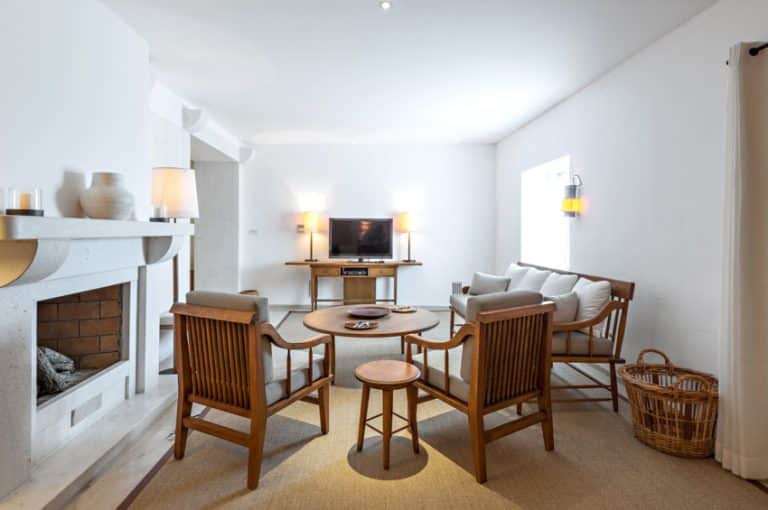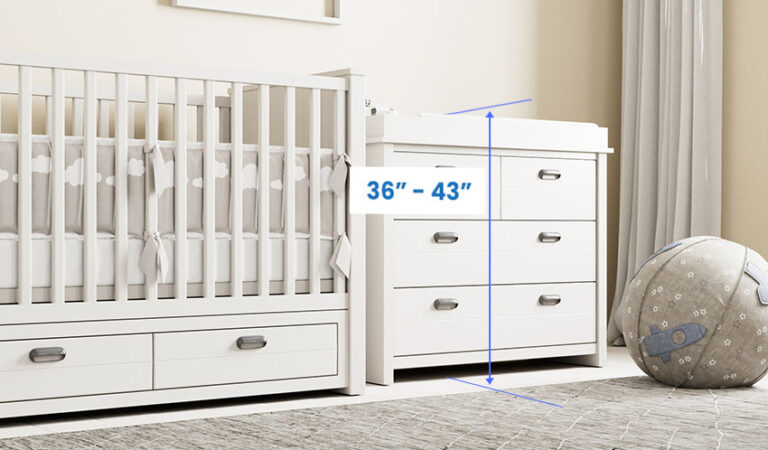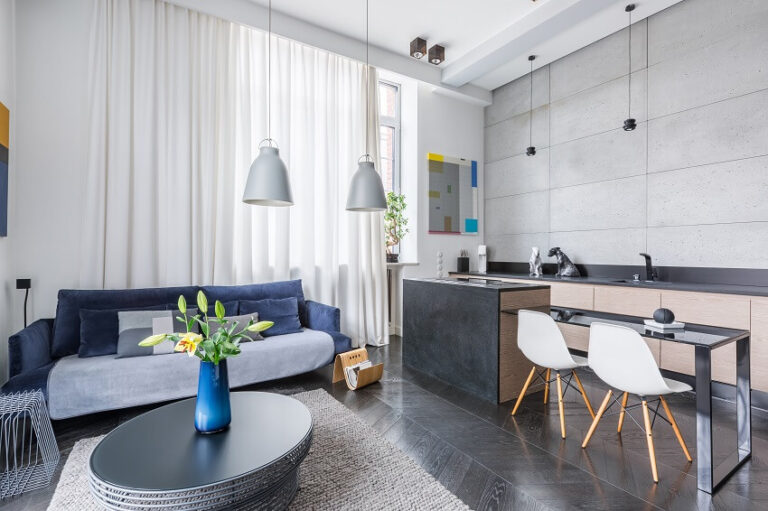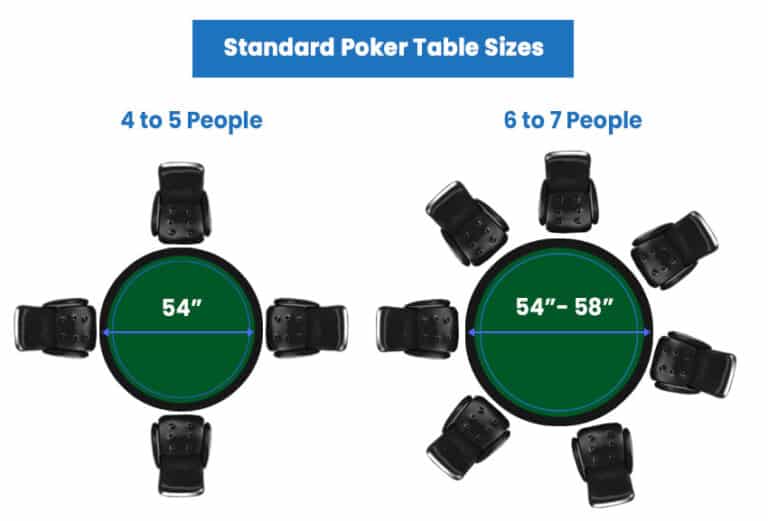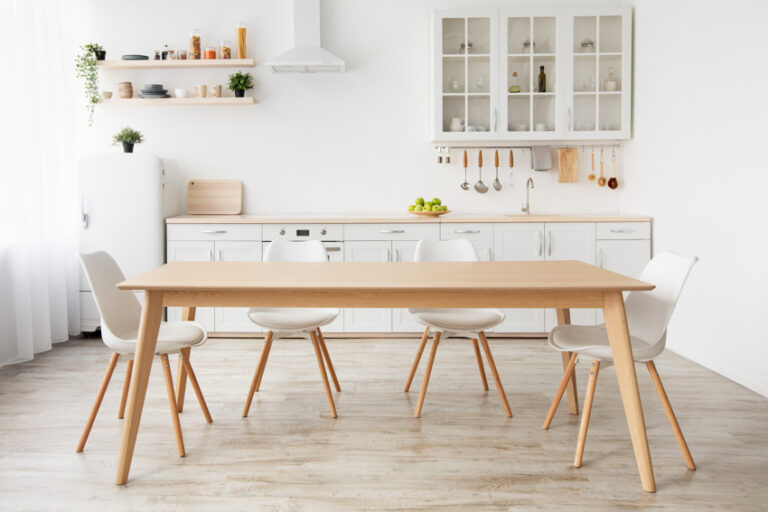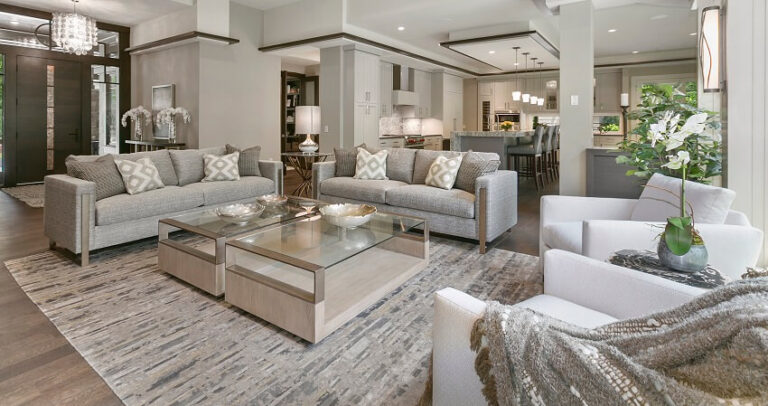50 Types of Sectional Sofas (Designs & Buying Guide)
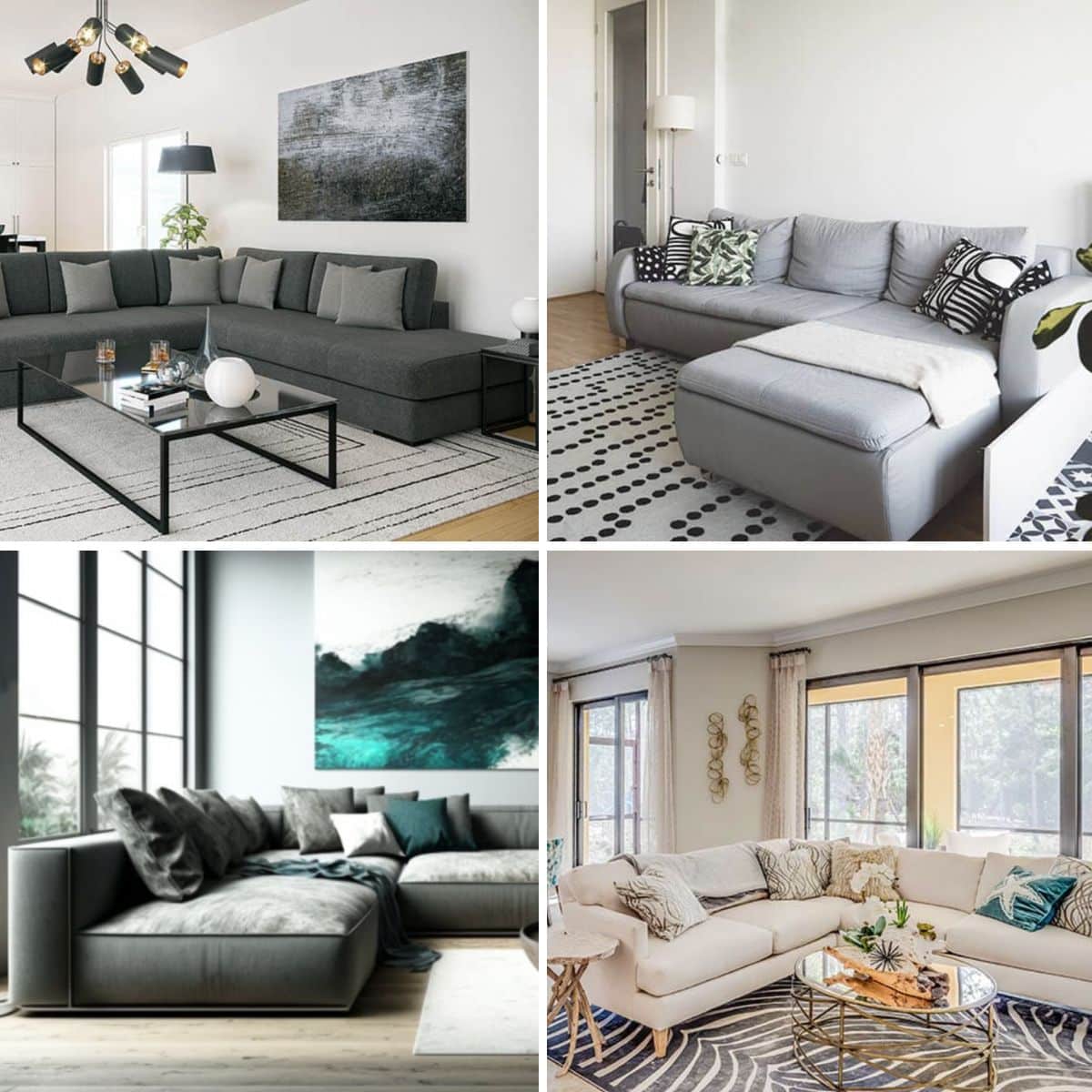
The sectional sofa is one of the most versatile and practical furniture pieces you can find in the market. First seen during the Victorian era, sectional sofas continue to grow in popularity and make their way not only into residential settings but commercial spaces as well. Sectional sofas are available in numerous designs, styles, and materials. You can find thousands and thousands of options in the market to suit your specific taste, need, and preference. To help you decide which one is the best for your home, we share with you our very own ultimate design and buying guide for sectional sofas.
What Is A Sectional?
Sectional sofas are a type of couch or seating made up of independent pieces or sections that can be arranged in different configurations. A typical sectional sofa usually consists of two to seven pieces, which ideally include fixtures that connect them from each other and prevent them from separating while in use.
Each “section” is a different type of seating — options may include an armless chair, a regular two or three seater sofa, sleeper sofa, a chaise lounge, ottoman, or storage.
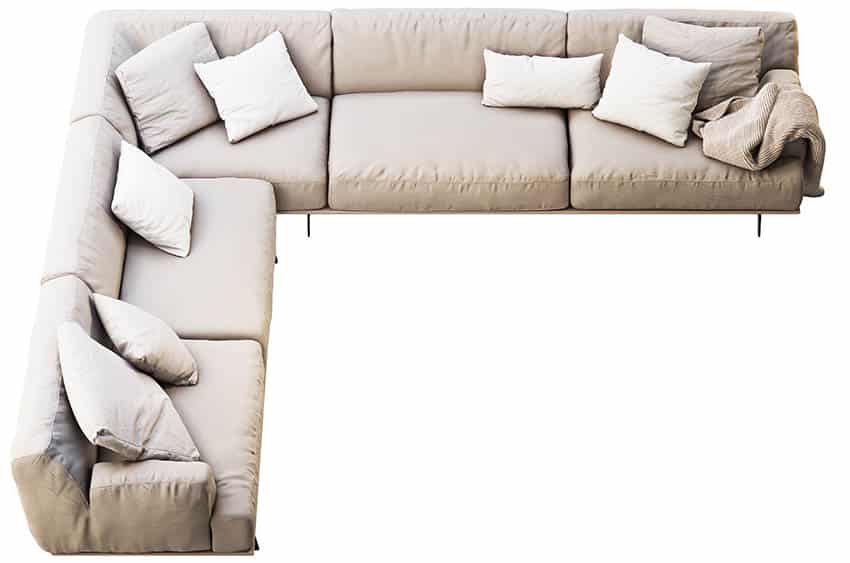
The biggest advantage that a sectional sofa offers is design flexibility and versatility. Unlike a three seater sofa, a sectional can be modified into different layouts to fit into a space — it can be formed into an L shape seating area, a U shape seating area, or a standard single seating area. This type of sofa can be customized easily according to your needs and your space.
Sectional Shapes and Designs
The designs of sectional sofas are mainly classified according to their shape. In general, sectional sofas have three main shapes, namely U-shape, L-shape and semi-circular shape. The shapes may take on different designs and typically come in modular sets of three to seven pieces which can be arranged in different configurations.
L-Shaped Sofa
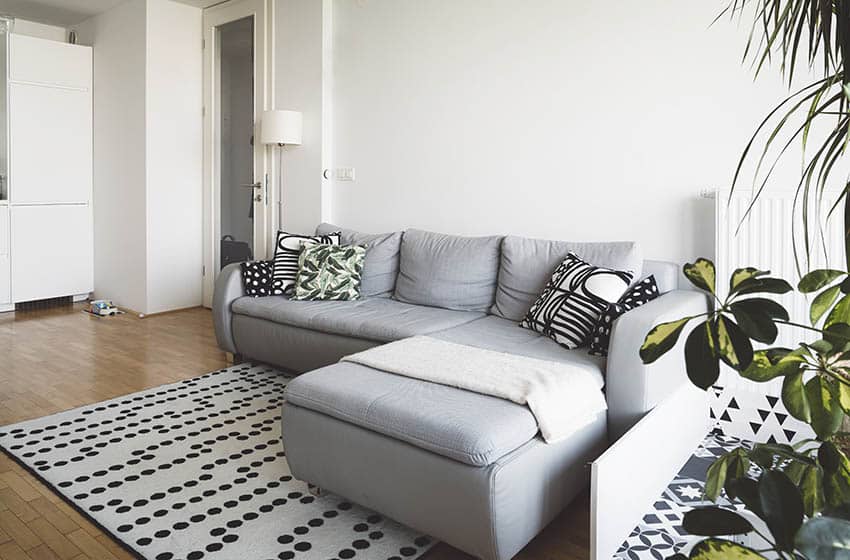
These sectional sofas take on the form of the letter “L” and come standard with a chaise. L- shaped sectional sofas are perfect for homes that have small living rooms as they help optimize the seating space. L-shaped sofas allow for easy reconfiguration without cluttering the room and since they come with a chaise, it is easy for the user to recline, sit and relax.
U-Shaped Sectional
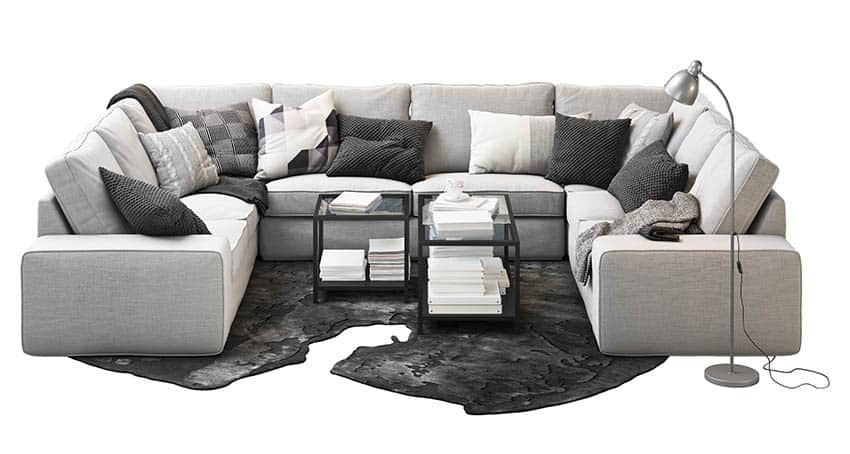
The U shaped sectional has more space compared to a standard L shaped sofa. As its name suggests, it takes on the form of the letter “U” and allows the user to recline on either ends of the sectional. A u-shaped sectional sofa is a great choice for homeowners who have large living rooms since they are usually bulkier compared to other sectional sofa shapes.
Semi Circular or Curved Sectional

Curved sectional sofas have a more graceful form compared to L shaped and U shaped sofas. In this sectional sofa design, there is no uncomfortable corner seat and the users can comfortably sit and talk easily on all parts of the sofa.
Corner Sectional
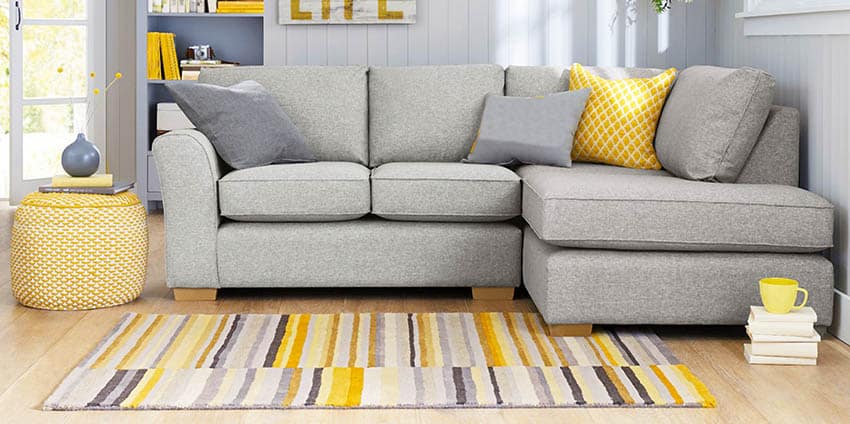
Corner sectionals have individual pieces that come together at a 90 degree angle , thus forming a “corner”. Depending on the design, the corner pieces may sit between other individual pieces of the set.
L-shaped corner sofas are most appropriate for large and open-plan rooms. where they can be placed against two adjoining walls to fill a perhaps otherwise insignificant corner. – Step-by-Step Home Design and Decorating, DK 2012
Corner sectionals are ideally p[laced on one side of the room, but they also work great when placed in the middle of a space, especially if you have an open plan. This type of sectional sofa can be used to divide a room without being an obstruction to the space.
Reversible
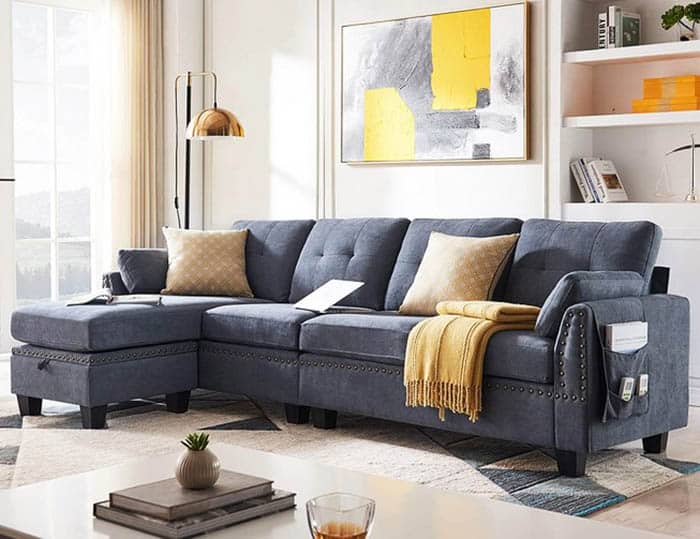
If you want something versatile, functional, flexible and convenient, reversible sectional sofas are your best bet. Reversible sofas give you the ability to rearrange the pieces to create different layouts. A reversible sofa makes great sense for those who move a lot or enjoy constantly rearranging the furniture layout in their home.
This type consists of a standard sofa with two arms and a stand-alone ottoman piece. You can put the ottoman on either side to create a right facing or a left facing sectional, depending on your need.
Left Or Right Arm Facing Sectional
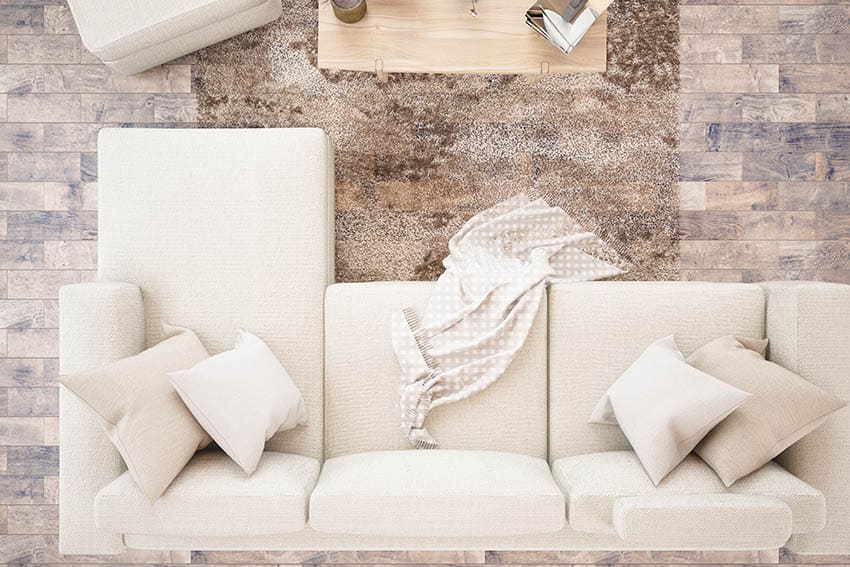
A sectional sofa’s orientation may either be left arm facing (LAF) or right arm facing (RAF). A left arm facing sectional has a longer seating piece on your left side. When you look directly at the sofa, the chaise or lounge is on the left side. Whereas, a right arm facing sectional is the exact opposite — the chaise or longer piece is located on the right hand side.
Reclining Sofa
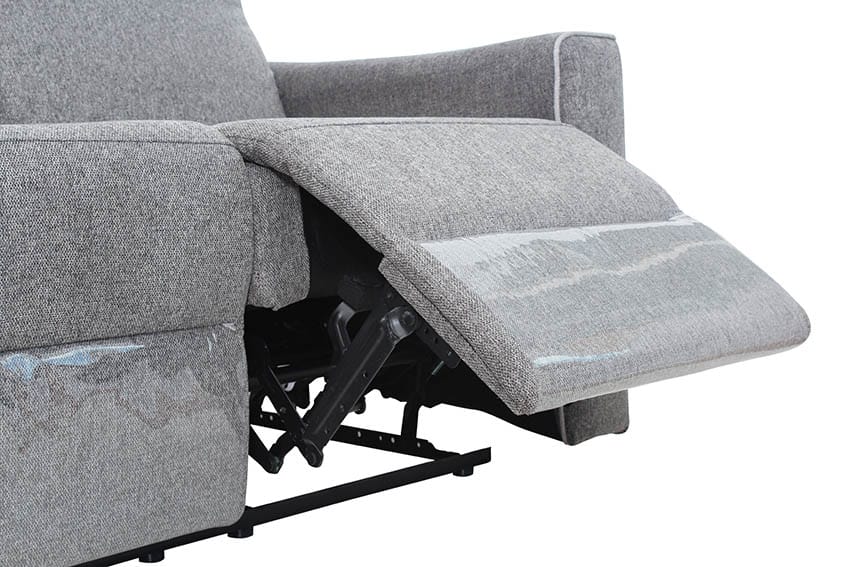
Reclining sectional sofas are commonly used in entertainment rooms, media rooms and family rooms. In this design, the user can recline comfortably while reading a book, watching a movie or hanging out. The design of reclining sections vary widely — some come with sections which can be adjusted, while some look like theater chairs. They are more suitable for large rooms because they take up a lot of space.
Reclining sectionals can either be manually operated or power operated. Power reclining sofas recline easily with a touch of a button. They usually come with added features like massages, heated seats and USB ports. Whereas, manual reclining sectionals recline by pulling a lever. This type is a lot cheaper than power recliners because they do not have any special features.
Sleeper Sofa

A sleeper is a sectional sofa which can be converted into a bed or a sleeping area. Generally heavier than other sectional sofa designs, sleepers are perfect if you want to maximize the use of a room. With a sleeper sofa, you do not need a spare bedroom guest room as you can easily convert any space into an extra sleeping area.
Sectional With Chaise
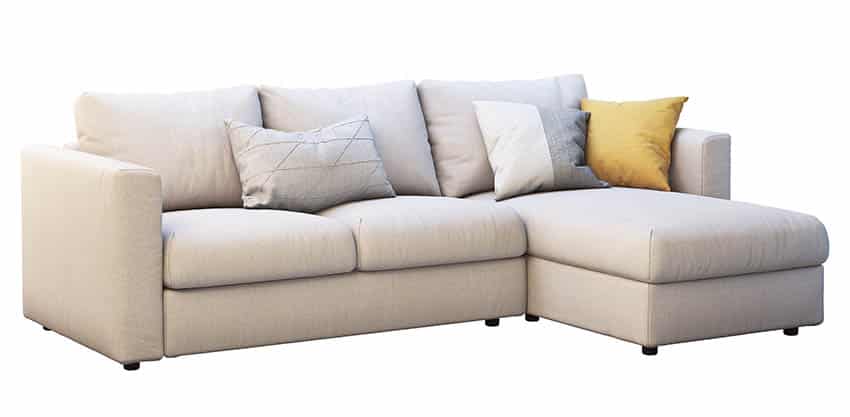
A chaise is an upholstered sofa that is long enough to support the legs. Also known as a “chaise longue” — a French word which literally translates to “long chair”. Most sectional sofas consist of two or more pieces and it typically includes one chaise. The part with the greater seat depth which allows for reclining, lying down and stretching the legs is the chaise. This type is perfect for relaxing and lounging. Some larger sectionals designed for couples or families come with two chaises
I find that the most useful are those that allow the “leg” of the sofa to be positioned on either side of the main body of the unit. Because of the size and expense, I use sectional sofas only in large rooms where the additional seating is clearly needed. Sabrina Soto: Homedesign: A layer-by-layer Approach
Deep Seat Back Sectional
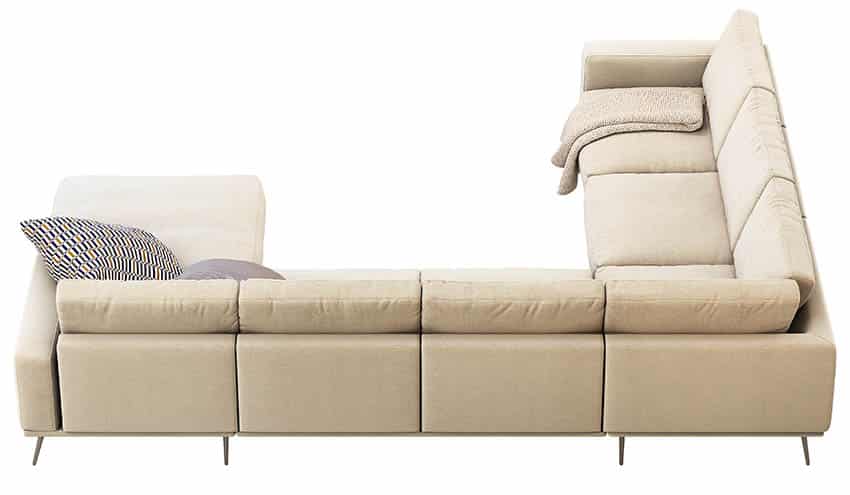
Typically, sectional sofas and other types of couches have a standard inside depth of 21 to 26 inches, and a standard outside depth of 31 to 40 inches. The inside depth refers to the space between the front of the seat and the sofa’s back cushion, while the outside depth is the distance from the back of the couch to the front. Sectionals and other sofas that follow this standard seat depth are categorized as “shallow seating”.
Sectional sofas with deep seats have a depth of more than 40 inches. This allows the user to lean back comfortably or lay down on it. On the other hand, shallow seats will only allow the user to sit in an upright position with their feet on the floor.
Low Profile Sofa
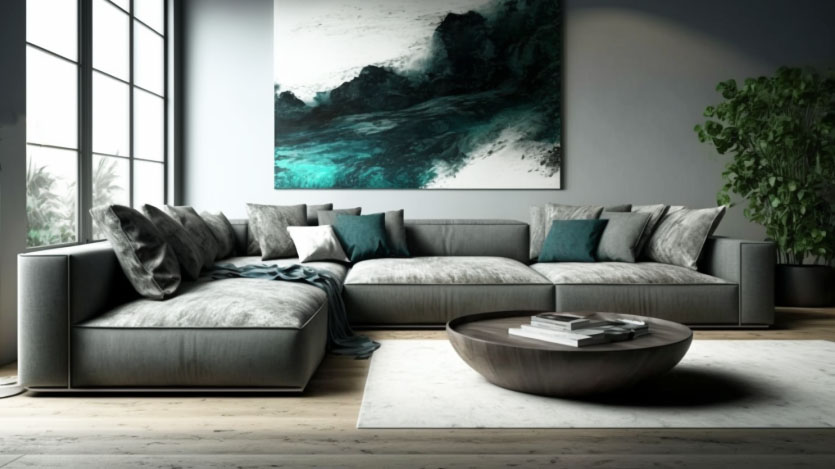
Nailhead Sofa
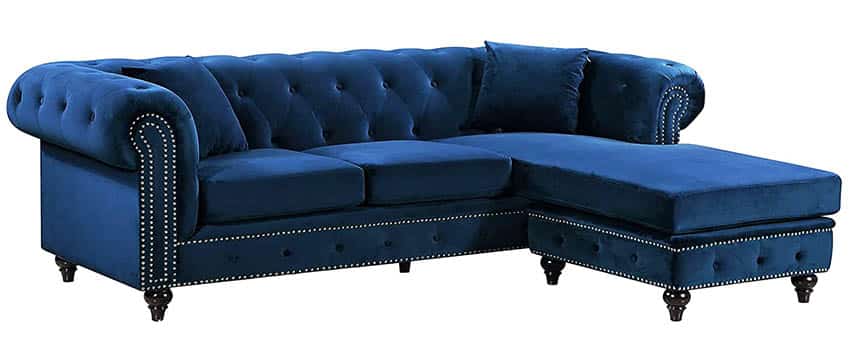
A Nailhead is a classic furniture design detail used in traditional pieces and sofas that have a refined style. Also known as a “nailhead trim”, it consists of a series of metal studs or nail heads used to hide the places where the upholstery is tacked into the wood frame. Sectional sofas with nailhead trims are perfect if your home’s interior style leans towards the traditional, transitional or contemporary.
Stationary

The most common type of sectional sofas are stationary and are designed with a single shape. Unlike modular sofas which can be mixed and matched, these pieces lock or connect together so that they stay in place. The only downside to having stationary seating is that you can’t recline in them.
Modular Sectional
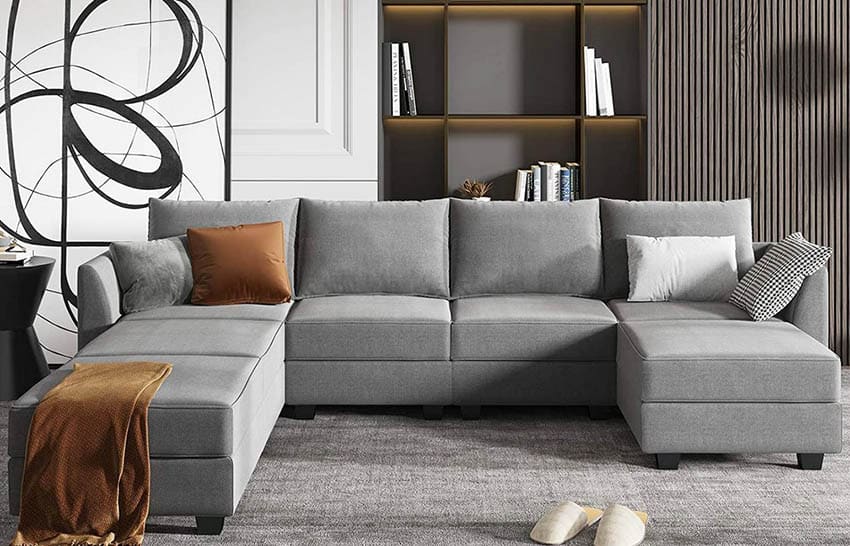
Modular sectional sofas come in 3 to 5 pieces. Each individual piece of a modular unit can be used as stand-alone furniture, but together, they can be rearranged to form different styles and configurations. Modular sofas are very practical because not only do they optimize the seating choices that you have, but they can be easily moved around to suit your taste and needs. With a modular type of seating design, you can push the pieces together to form one long setting you can place them on different sides of the room.
Custom Sectional
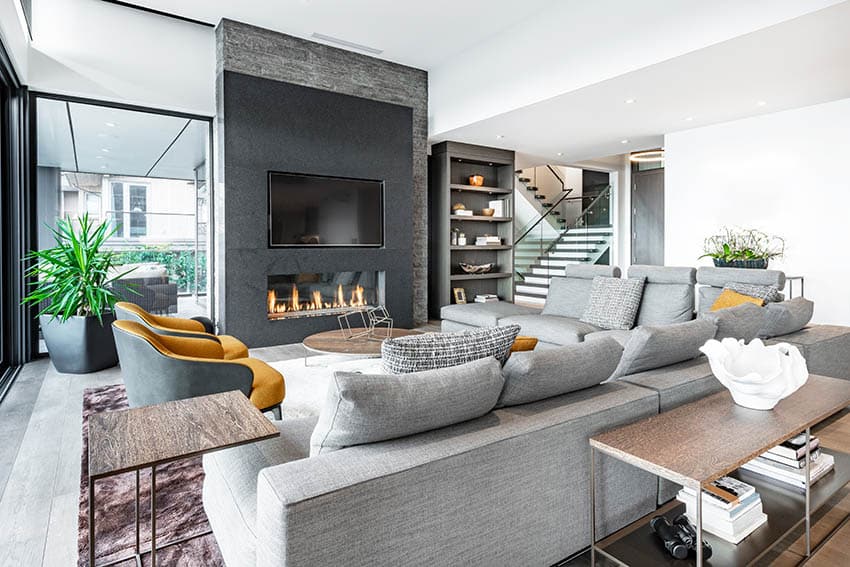
Custom made sectional sofas allow for complete modification of the design, style and material of the furniture piece. Custom furniture designs are generally more expensive than a ready made product, but gives you more creative freedom to produce a piece that will fit your exact specifications and needs.
Plaid
Not all sectional sofa upholsterers are in plain solid colors, you can find manufacturers which upholster them in beautiful plaid textiles, perfect for informal settings and a casual laid back vibe. Plaid patterns are crisscrossed vertical and horizontal bands.
Stripes
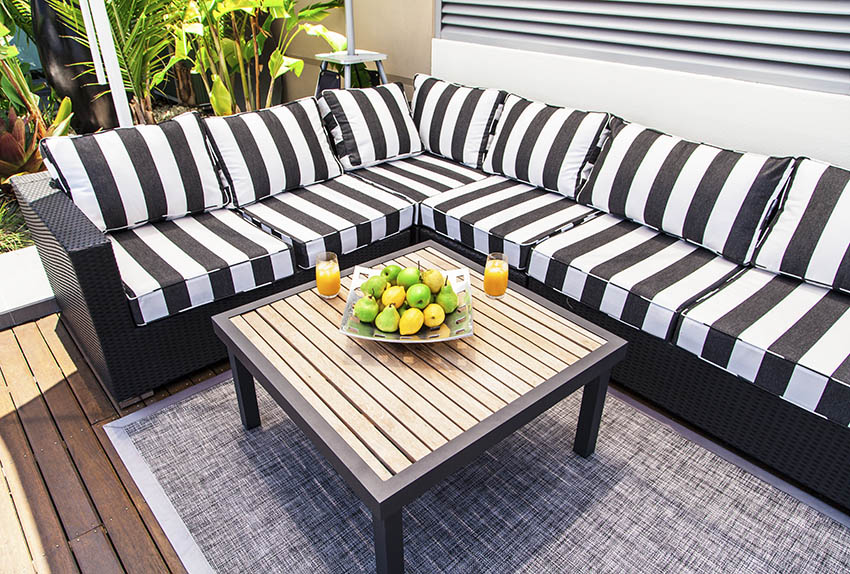
Aside from plaids and florals, other prints and patterns which can be used for sectional sofas are stripes. Stripes are perfect if you want to experiment with prints but do not want to commit to bold patterns. Stripe fabrics are perfect for casual settings, coastal themed interiors or a navy motif. You can opt for this type of fabric design if your home has a contemporary style.
Floral
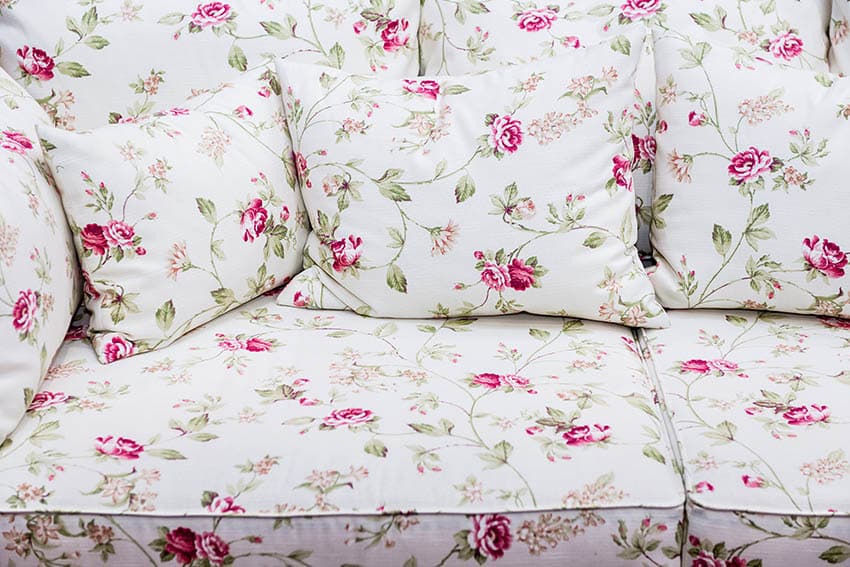
Another fabric design option is floral. Floral sectional sofas can help bring in a feminine touch to a space and will work well in charming cottage homes, traditional spaces and shabby chic interiors.
Sectional Pieces
As we have mentioned in the definition, the number of pieces of a sectional may range anywhere between two to seven pieces, depending on the design. Each section is a different type of seating, which may include an armless chair, a regular two or three seater sofa, a sleeper sofa, a chaise or an ottoman.
Outdoor Sectional
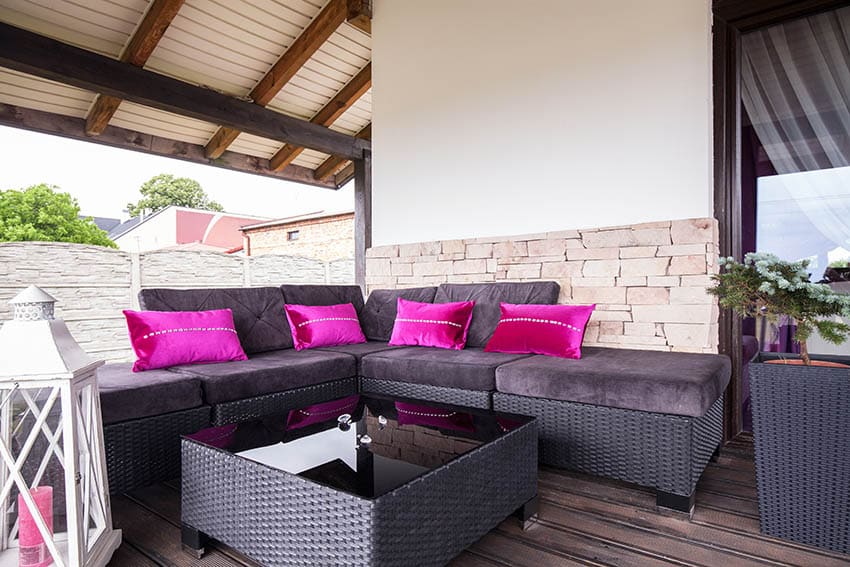
Some manufacturers produce sectional sofas which are suitable for outdoor use. These lounging types are made with materials that can withstand changes in climate and weather. The fabrics and upholstery used for outdoor sectionals are also weatherproof and easy to maintain. Some materials used for this include wicker, rattan, solid wood and metal. In general, they are much more expensive than indoor units.
Sectional Styles
Aside from the form and details of the sectional sofa, another design factor that you can consider when buying is the style. Before you decide which style to use, you must have a clear understanding of the prevailing overall theme, style and color palette of your home. This will ensure that the resulting look will be cohesive and harmonious. Here are some of the most common sectional sofa styles :
Traditional
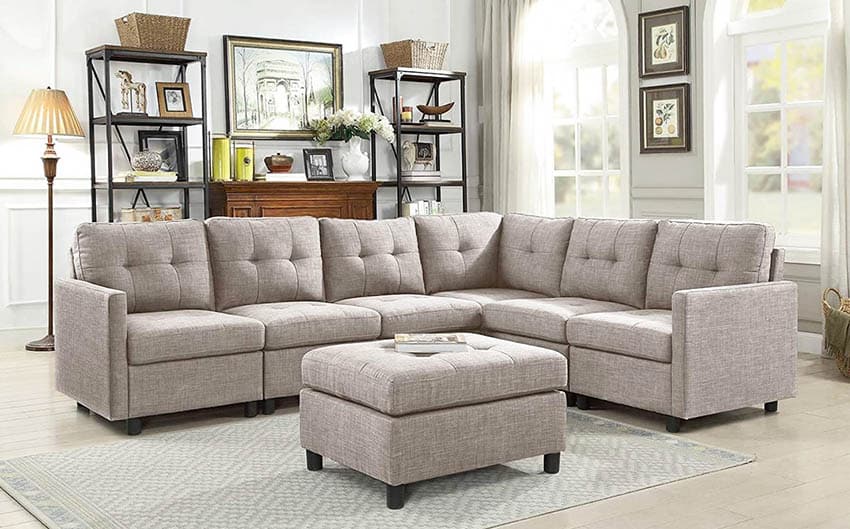
In general, traditional style furniture is more ornate, luxurious and graceful than its modern counterparts. Typically, traditional style sectionals are daintier, have a curved form and soft edges. The accents and details are fancier, while the colors are richer. If made with mixed materials, traditional sectionals often make use of rich wood tones and plush patterned upholstery. The legs are also typically turned or in cabriole style, finished in deep wood stain or gilded.
Modern

Also referred to as Mid century modern, Modern style furniture was popularized during the late 19th century up to the present. Sleek and streamlined, modern style sectionals are highly characterized by their sharp lines and strong geometric form. They also have more updated touches like metal accents, thin legs, while the fabrics and upholstery used are usually in plain solid color. There is little to no ornamentation used and overall, they tend to be “boxier” in appearance compared to traditional sectionals.
Mid modern century sectionals are also usually made with leather — often with a tufted back . This type of sectional is perfect if you want to add lightness to a room as their visual weight is less compared to ornate traditional sectionals.
Contemporary
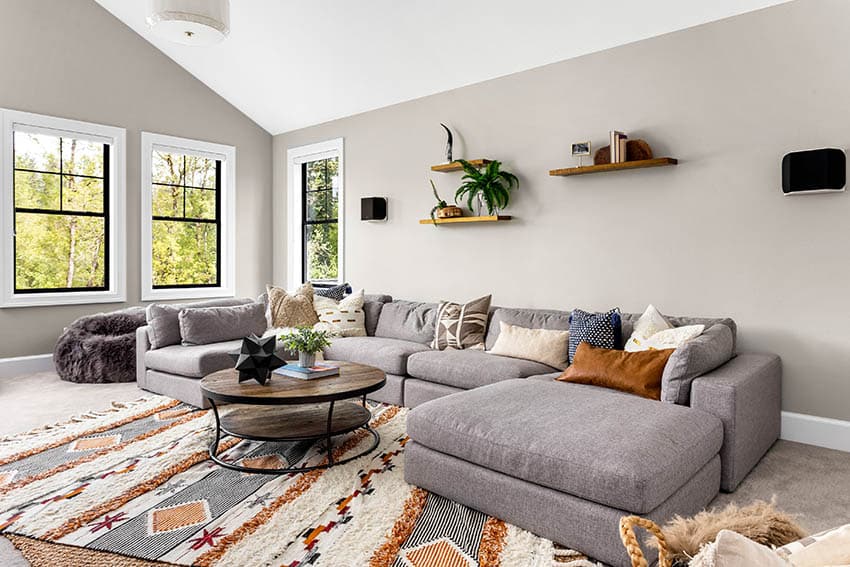
Often confused with modern furniture, contemporary style furniture borrows inspiration from all styles and eras — from Mid century Modern to present. Contemporary style sectionals have a strong minimalist appeal that is characterized by simple clean lines and squared edges and prominent geometric form.
They are typically made with natural materials like wood or metal and upholstered in neutral colored fabrics like black, white, gray, beige or brown. The fabrics are also often textured but other than that, there are no ornate details present.
Farmhouse
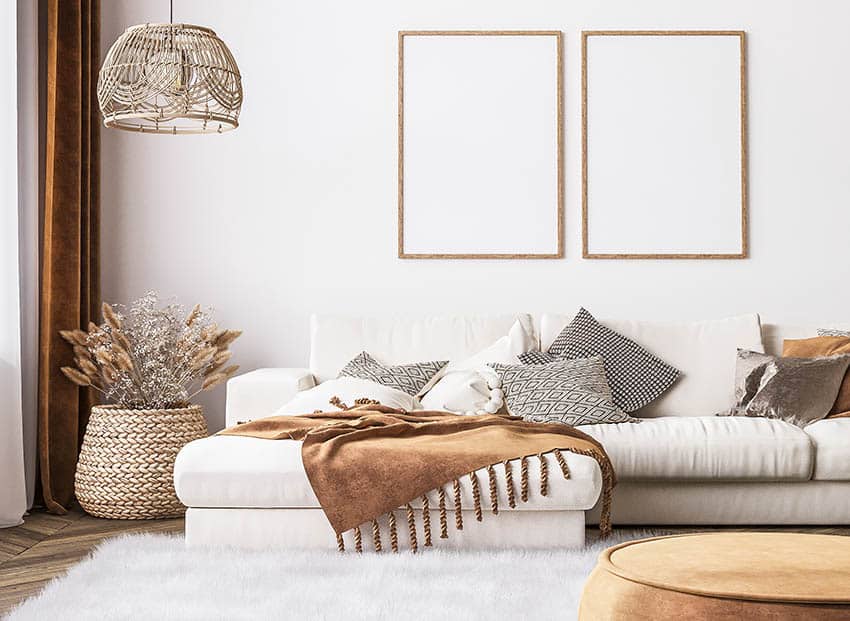
The basic elements of farmhouse style furniture include neutral colors, durable fabric and comfort. Farmhouse style sectionals have a strong rustic appeal, typically made with natural materials like wood, upholstery in muted shades with a few pops of colors. Farmhouse style sectionals have a simple and timeworn appearance and are built to last. They are the perfect choice if you want to evoke a laid back vibe in your space.
Rustic
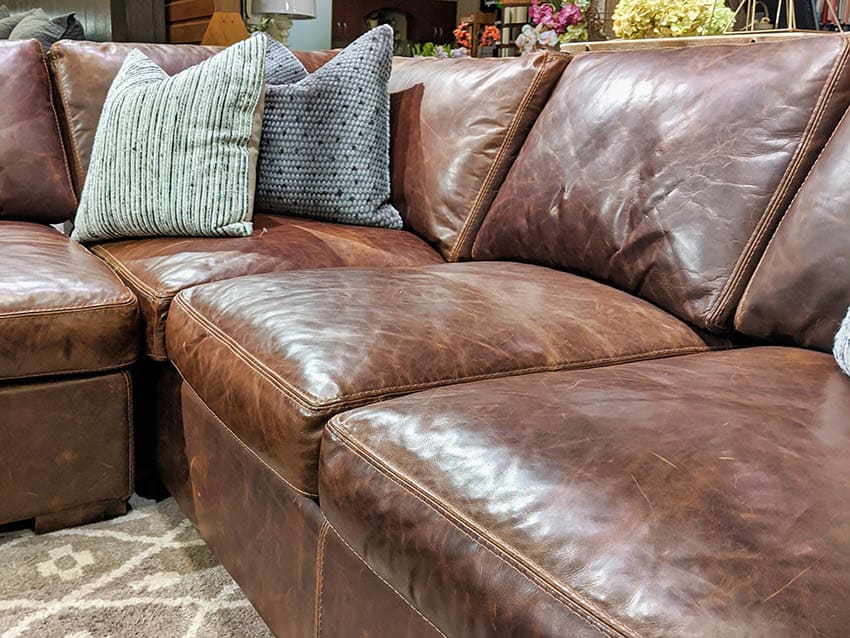
Generally speaking, rustic style furniture are very simple, natural looking and have a timeworn appeal. Rustic style sofas emphasize the use of natural materials like distressed and solid wood, and textured fabrics like canvas or burlap. They look very organic and are plain, unornamented yet very utilitarian.
Transitional
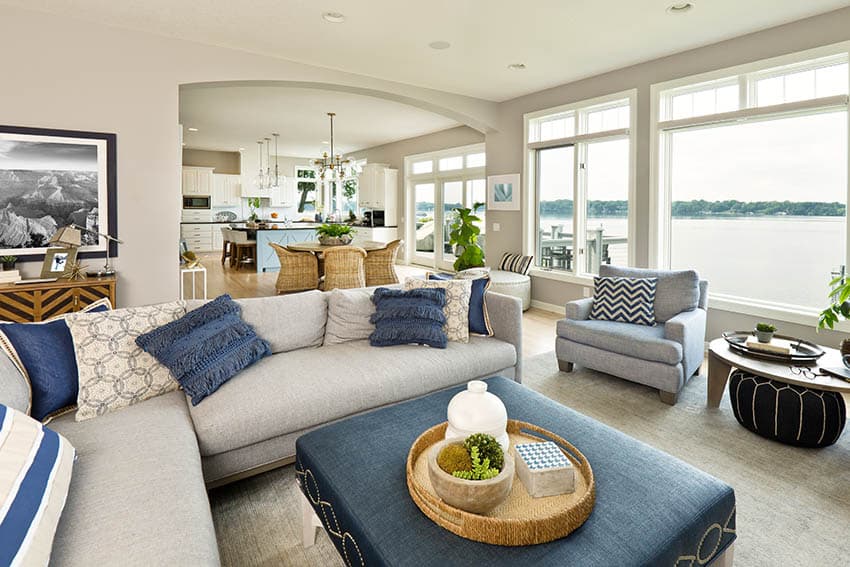
Combining the best of both traditional and modern furniture styles, transitional furniture focuses on rendering a sophisticated appeal without having to use ornamentation. Typically transitional style sofas have neutral colors and have metal or wooden legs.
Coastal
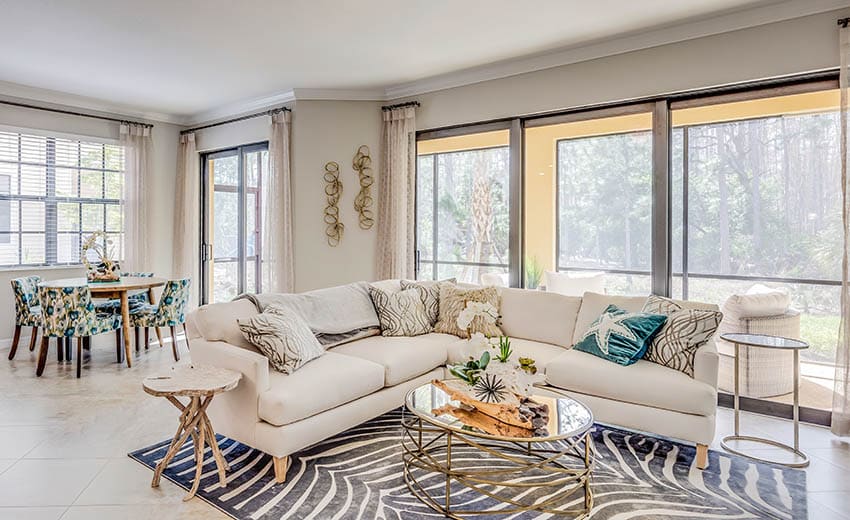
Coastal style furniture are known for their relaxed and refreshing vibe. Coastal style sofas usually incorporate the use of natural elements like rattan, woven wicker or weathered wood. Coastal sofa fabrics are often simple, typically in light colors like beige, ivory, blue or green. Some other popular materials used in this furniture style include canvas.
Sectional Fabrics & Upholstery
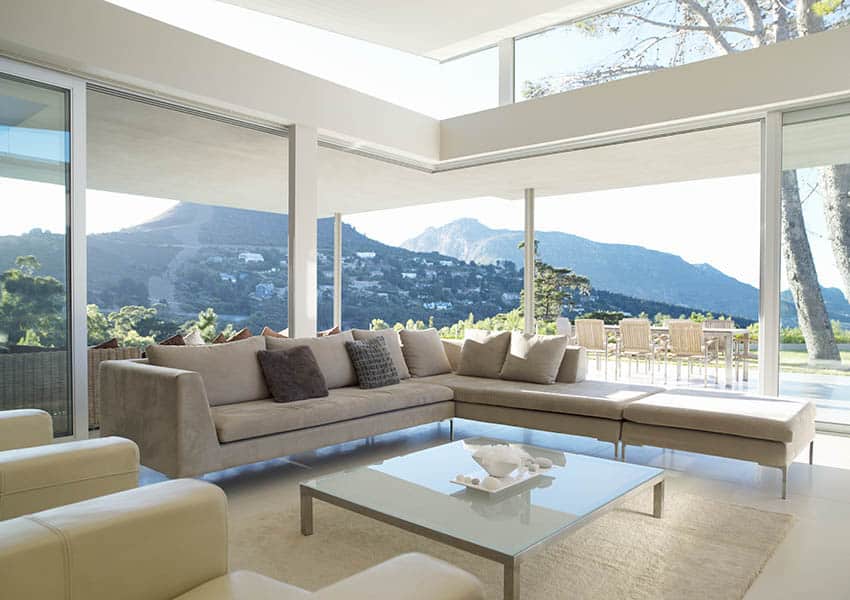
There are a lot of fabrics and textiles which you can use to upholster a sectional sofa, and the type of material you choose greatly impacts its performance, life span, comfort and appearance. With the wide array of options available in the market, you can surely find the right fabric and upholstery which can suit the style of your home and fit your budget.
Polyester Fabric
Polyester is one of the most common types of microfibers used in upholstery. Because of its ability to withstand daily use, most furniture manufacturers and homeowners alike tend to go with this choice.
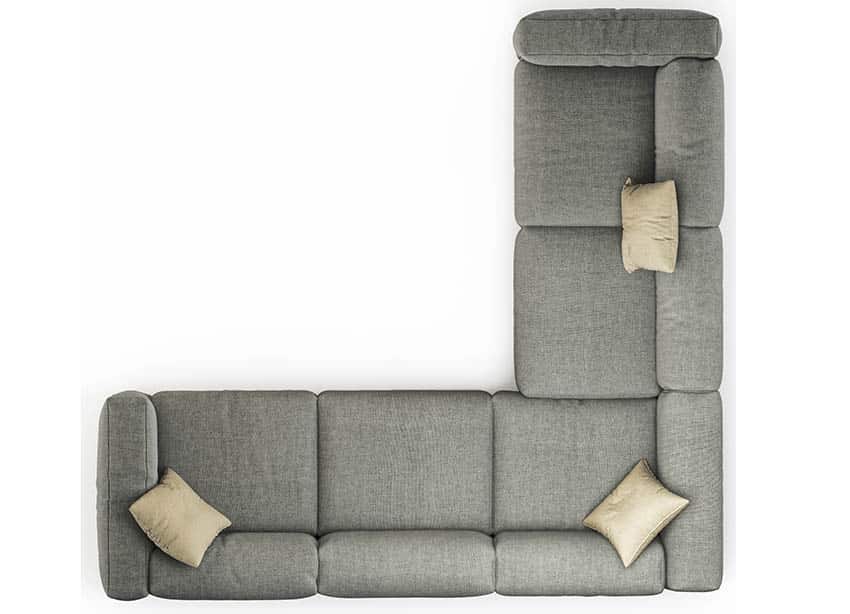
Pros of Polyester:
- Polyester is very soft and comfortable to use as an upholstery material
- Polyester is durable. This type of fabric lasts a long time, is stain resistant and abrasion resistant. Since it does not fade easily, you can place your sectional sofa near a window , without having to worry about it discoloring under the sun.
- Polyester fabric is low maintenance and easy to clean. This fabric also dries very quickly in case of spills or washing.
- Unlike other breathable fabrics, polyester does not absorb smells.
- Polyester is available in a wide variety of colors , thus offering dozens of choices in terms of design and style.
- In terms of appearance, polyester gives furniture an “expensive feel” and makes it very attractive.
Cons of Polyester:
- Like most upholstery fabrics, polyester is flammable.
- Although polyester is resistant to most stains, grease can be quite hard to remove from it, so you need to be careful if you plan on snacking on fried foods while on your polyester sectional sofa.
- Polyester has the tendency to crack when exposed to fluctuating temperature or extreme hot and cold.
- Polyester is a tensile fabric and may stretch over time.
We’ve written more about polyester couch pros and cons here.
Cotton Fabric
Cotton is the most widely used natural fiber in upholstery fabrics. Aside from being the cheapest, there are a lot more practical reasons which make it a very reliable material for furniture use.
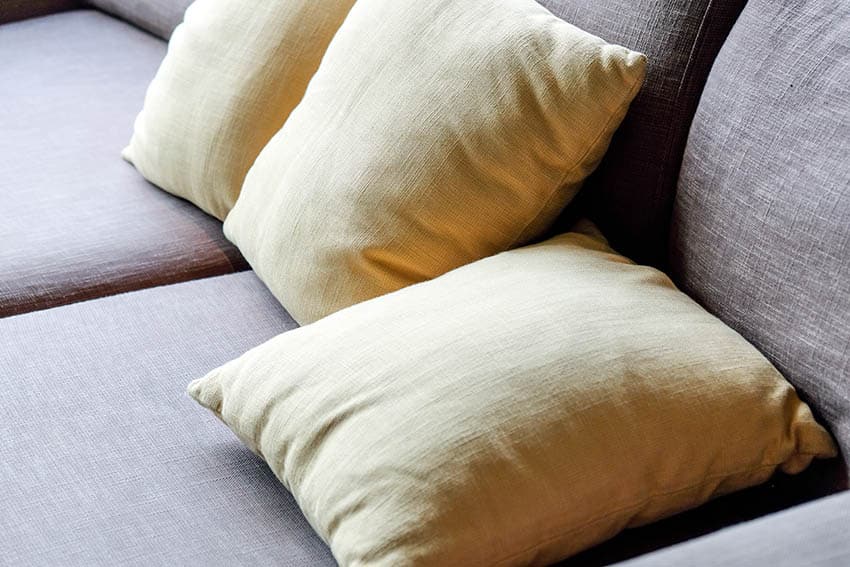
Pros of Cotton:
- Cotton is soft, comfortable and breathable. It gives furniture an over all soft feel.
- Cotton is very durable and resists pilling and fading. It is also resistant to abrasion.
- Cotton is 100% natural and hypoallergenic, which makes it highly suitable for people with sensitive skin.
- Cotton can be dyed in almost any color, which means you can find it in different hues which can match your interior style. In the same way, it is available in different styles, patterns and designs so it’s easy to find the perfect cotton sectional sofa which will match the decor of your space.
- Cotton fabric is easy to care for and can withstand moderate stains. You can easily clean it and get rid of stains without needing special treatment.
- Cotton fabric is available in different grades which means it fits most budgets, whether low , mid or high.
Cons of Cotton:
- As mentioned, cotton fabric can easily accept dyes. However, this can pose a problem because it also makes it highly susceptible to staining. For example, a cotton upholstered sofa can easily catch dyes from blue colored jeans.
- Cotton fabric also has the tendency to soak in spills quickly. If not quickly dried, your cotton upholstered sectional may develop an unpleasant odor over time.
- Cotton fabric wrinkles easily.
- Because of being susceptible to stains, dust and dirt, cotton upholstered furniture is not the best choice for everyday use furniture.
Linen Fabric
Linen is another type of natural fiber and it is derived from the flax plant. Oftentimes, it is mixed with synthetic fibers to improve its strength and qualities. Linen is one of the affordable upholstery fabrics used in the market today.
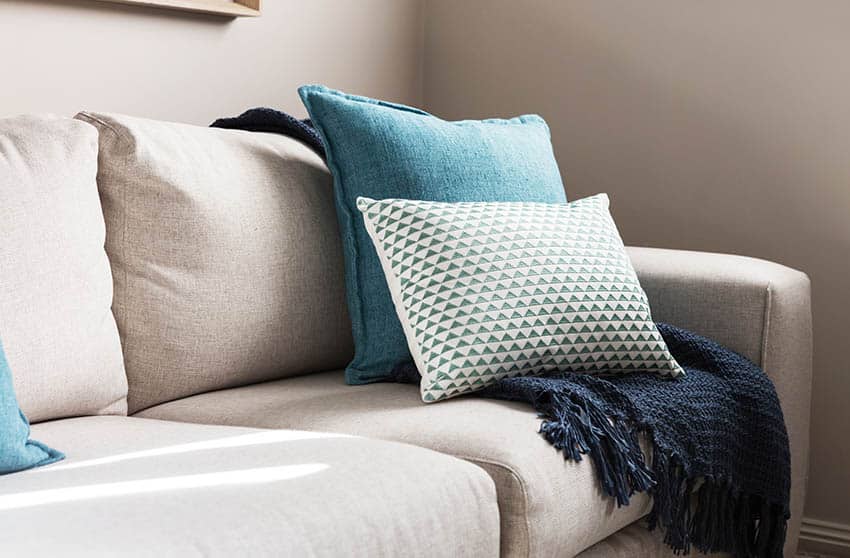
Pros of Linen:
- Linen has uneven fibers, which gives furniture an attractive texture and alluring feel.
- Linen has a natural luster and makes furniture very elegant.
- Very comfortable to use as an upholstery material because it is fort and smooth to the touch.
- Linen does not pill or develop small balls of thread on its surface.
- Linen is resistant to abrasion and fading. Linen is also resistant to mildew, making it antibacterial.
- Because it is natural, linen is also very eco friendly.
- As mentioned, linen is very affordable and inexpensive compared to other upholstery materials.
Cons of Linen:
- Although durable, linen is not suitable for heavy use.
- Linen wrinkles quite easily, which makes it not recommendable for everyday furniture or for households with small children and pets.
- Even if linen stands quite well to fading, it can get soiled and stains easily. Linen also has the tendency to shrink when washed. To ensure its perfect quality and to avoid damaging its original size, you need to hire a professional cleaner.
Genuine Leather
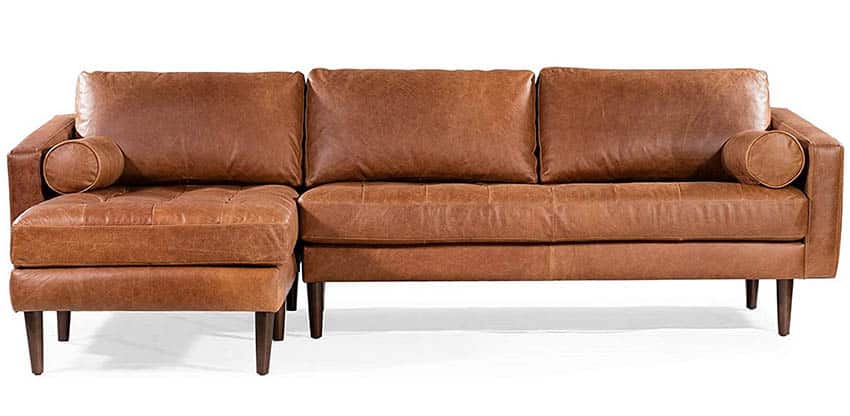
Leather is derived from the hides and skins of animals. While not a fabric, most people opt for this material for the furniture pieces because of its class, luxurious feel and masculine touch. There are different types of leather sofas and they can vary in quality depending on the material used.
Pros of Genuine Leather:
- Genuine leather is very comfortable to use as a furniture upholstery. It has an exquisite texture, feels luxurious and is amazing to the touch. It also has a distinct smell which most people associate with something expensive.
- Genuine leather looks even better as it ages and develops a patina or mild discoloration which adds a unique beauty to furniture.
- It holds its value better than other upholstery materials
- Genuine leather is easy to maintain compared to other upholstery materials. You can easily wipe off any liquid using a cloth. It does not absorb liquid or gets stained easily unlike fabric.
- Because it does not absorb spills, genuine leather furniture does not smell bad. On the other hand, some furniture upholstered with fabric can develop undesirable odors.
- Genuine leather furniture is very durable and has an average lifespan of 5 years, provided that you take care of it well. It is suitable for heavy use.
- It is well suited for households with pets or for those who smoke.
Cons of Genuine Leather:
- Some homeowners still prefer fabric over leather because it is a bit harder.
- Leather had tanned skin, which can split or crack over time. It can also get damaged easily from sharp objects.
- Although quite resistant to liquids, some spills on genuine leather will often require professional cleaning.
- Leather upholstered furniture is a lot more expensive than fabric.
Read more about leather vs fabric sofas here.
Faux Leather
Faux leather is one of the names used to refer to synthetic leather. Faux leather is composed of man made materials and is often used in furniture upholstery because it gives you the same look of genuine leather for a fraction of the price. Although not as soft as its authentic counterpart, faux leather has its own positive characteristics which make it a good alternative.

Pros of Faux Leather:
- Can render an elegant and luxurious feel to a home
- Durable and can last for years.
- Furniture upholstered with faux leather does not require to be professionally cleaned.
- More affordable compared to genuine leather
- Is more environment friendly.
Cons of Faux Leather:
- Faux leather does not age gracefully and won’t develop patina over the years.
- It can crack an tear more easily than real leather
- Faux leather can release harmful chemicals that may be harmful to your health
Chenille Fabric
Chenille is one of the softest and plushest natural fabric you can find. Its name actually means “caterpillar” in French because its texture is very fuzzy and it has piles that protrude around the weave. Aside from its super soft feel, a lot of furniture manufacturers use Chenille as an upholstery material because it is very stretchable. Because it is a casual fabric, Chenille is more commonly found in children’s furniture and everyday comfort furniture
Pros of Chenille:
- Chenille upholstered furniture is super comfortable, very plush and soft to the touch.
- It is a very durable fabric and can stand up to hard use.
- Chenille is available in a wide variety of colors.
- Because of the way it is constructed, its colors also appear to have a variation in shade and produces an interesting visual effect once the light hits it.
Cons of Chenille:
- Because Chenille is extremely stretchable, it needs a backing material for upholstery. This translates to additional costs in terms of production.
- Chenille upholstered furniture needs frequent cleaning because dust and debris can get stuck in its long fibers.
- Chenille upholstered furniture is not suitable for use in homes with pets.
Microfiber Sofa Fabric
Microfiber is an ultra soft synthetic fabric that is made up of polyester and polyamide ( plastic and nylon). The fibers in this type of fabric are split into very fine strands, which makes the material porous , ultra absorbent and enables it to dry quickly.
Due to the way it is made, microfiber sofa fabric is perfect for a lot of commercial applications, such as sports gear, household use and furniture. Its ease of cleaning makes it a pet and kid friendly choice.
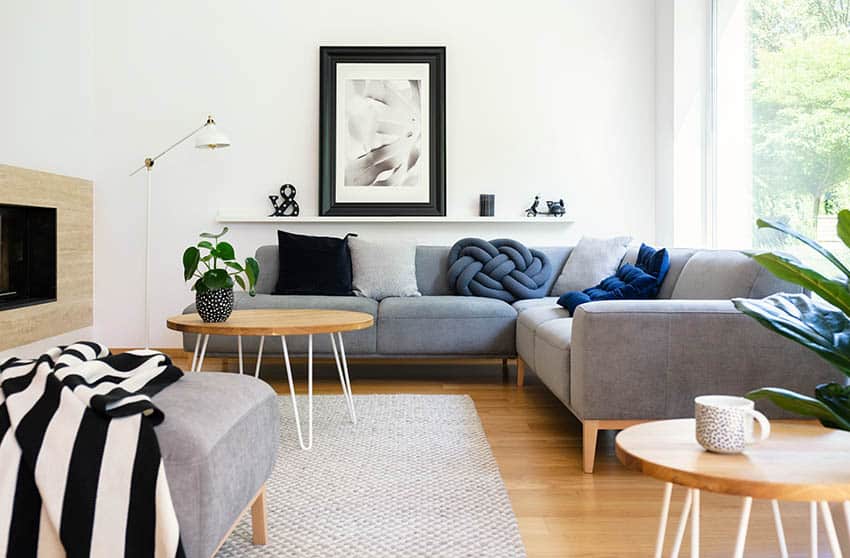
Pros of Microfiber:
- Microfiber is stain resistant and repels water. In the event of spills on your furniture, you do not have to worry because all you need is basic spot cleaning.
- Microfiber is durable. Because it is tightly woven , its quality is very durable and furniture upholstered with this fabric is designed to last for a long time. It does not get easily torn and stands up well to everyday use.
- Microfiber furniture is dust free. It doesn’t collect dust or lint, which also makes it highly suitable for people with allergies.
- Microfiber furniture is easy to clean. You do not need special equipment such as a steam cleaner or carpet shampooer to clean a microfiber sectional. All you need is some mild soap, water and a cloth — apply the soapy water solution to the area, clean it with a cloth and wait for it to dry.
- Microfiber is one of the most comfortable fabrics for upholstery. It has a soft texture.
- Microfiber furniture is suitable for households with kids and pets.
Cons of Microfiber:
- The biggest problem with microfiber is that because it is synthetically made, it can be a source of microplastic pollution.
- Can create a lot of electrical static to different materials
- The material can sometimes create swirl marks that make the sofa look dirty even when clean
Velvet Fabric
One of the most regal and richest fabrics in the market is velvet. It is commonly used in statement furniture pieces and accent chairs. Opt for this type of fabric upholstery if you want to add a touch of class and sophisticated flair to a space.
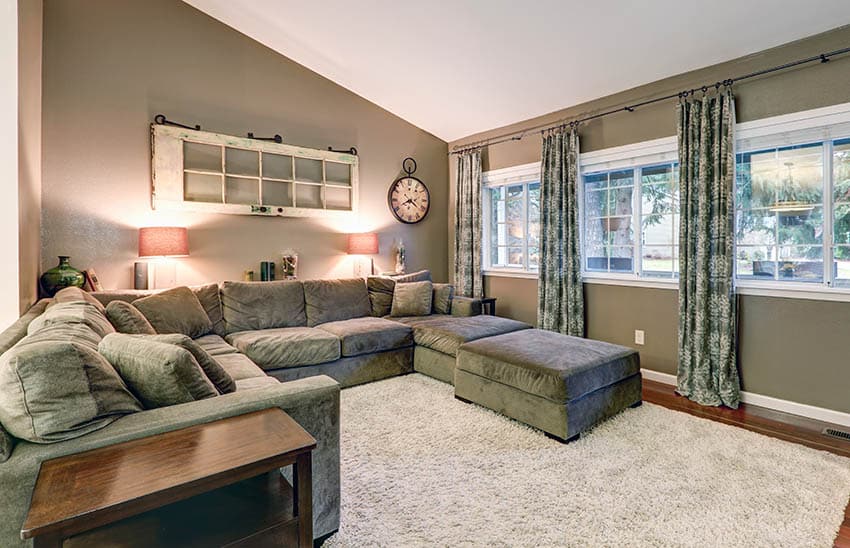
Pros of Velvet:
- Velvet has a very luxurious texture. Its smooth feel, soft texture and comfort is hard to beat.
- Velvet renders a very unique visual effect to a furniture. It has a nap in which the fibers pile and when it catches the light, it reflects it. It can also accentuate the form and shape of a furniture piece
- Velvet comes in a wide variety of colors. It is often dyed in rich hues and jewels tones like purple, emerald green, sapphire blue and ruby red — colors which can bring in an elegant and luxurious feel to a space.
- Velvet has excellent insulation properties. Thus, velvet upholstered furniture pieces are well suited for cold climates.
Cons of Velvet:
- Velvet can be quite difficult to maintain. It is a bit hard to clean, especially if it gets stained. You’ll need a steam cleaner to remove any dirt or stubborn stains.
- Velvet upholstered furniture wears out faster than other kinds of fabric. Its durability varies and depends on the density of the piles of woven fibers.
- Velvet is more expensive than other upholstery fabrics.
- Because of the rich texture and appearance of velvet, it is seldomly used for casual furniture. It is more typically found in traditional furniture and is more suitable for lush and formal furniture.
Twill Fabric
Twill fabric is the perfect choice for upholstery because it is sturdy and heavy. It is a type of fabric that has a distinct diagonal rib pattern.
This type of fabric usually has a lighter colored backside and a darker colored front side, which is also referred to as the “wale”. Twill also has a high thread count, which makes the material entirely opaque and very thick.
Pros of Twill:
- Twill fabric is very durable. The material can stand up to wear and tear well which makes it highly suitable for everyday furniture.
- Due to the way the fabric is made, twill fabric hides stains very well and it is water resistant.
- It resists wrinkling.
- Twill fabrics are very attractive. They are made with multiple colors of yarns and usually have unique patterns like hounds tooth and tweed.
Cons of Twill:
- Twill fabric is quite expensive compared to other fabrics that use plain weave.
- Twill upholstered furniture can be quite hard to clean.
- If used as a slipcover for vouchers, the fabric is prone to skewing and twisting if washed.
Sofa Back Styles
Sofa backs typically vary in shape, height and material. The style and design that the back of a sofa has will not only affect its aesthetics but the level of comfort it gives. Let’s take a look at the most common sofa back styles used for sectional sofas:
Cushion – As the name suggests, this type of sofa is padded by thick, plush cushions that are attached to its back. This is much comfortable and softer than a tight back sectional.
Pillow – Pillow baked sectional sofas come with removable pillows. These pillows are much smaller than cushions and almost resemble the design of throw pillows.
Aside from being super comfortable, this type of sofa back allows you to move around the pillows and customize it according to your needs. Pillow backs sectionals are perfect for sitting and reclining.
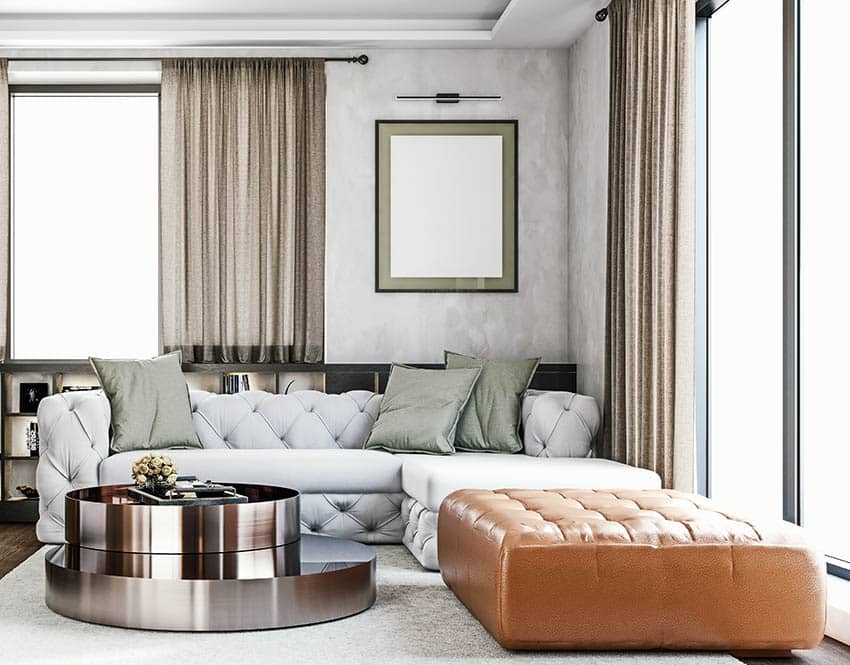
The overall result is highly textured and adds a lot of visual interest to the piece of furniture. Tufted backs are typically used in vintage style and traditional style sectionals.
Split – Split back sofas are made up of one or more panels which have loose, sewn -in cushions. They have a much smoother appearance than pillow and cushion backs because of their seamed, tight backs.
Because of their formal design, split back sectionals are perfect for contemporary styled rooms and for modern and minimalist spaces.
Tight –Tight back styles do not have any cushions or pillows, but instead they have simple, upholstered back panels. They have a very tight appearance because of their smooth edges, sharp lines and straight form.
Because of their streamlined look, tight back sectional sofas are very well suited for modern and contemporary homes.
Camelback – Dating back to the 18th century, the camel back is a traditional back that is shaped like a camel’s hump. This is more ornate than the other types of backs and has a much graceful form — with its middle raised and the ends sloping down lower.
The classic design, refined form and dramatic lines of camel back sofas make them highly suitable for use in traditional style spaces. However, with proper styling and accessories, they can also work for shabby chic spaces.
High Back – As the name suggests, high back sofas have a back that is much higher than a regular sofa. The standard back height of most comfortable sofas generally range from 26 inches to 32 inches.
However, for high backed designs, the height, or the distance from to floor to the top of the sofa’s back, can reach anywhere from 30 to 36 inches. High back models tend to lean more on a traditional style, while low backed ones are typically more modern and sleek.
45 Degree Angle – This type has backs which lean on a 45 degree angle. The back allows the user to slightly recline while seating. It is used in both traditional and modern styles.
Loose – Loose back sofas have cushions which are separated from the back,. Because the cushions are loose, they can be easily removed for cleaning.
Attached Back – The exact opposite of loose back sofas, attached backs have cushions that are sewn, clipped or fastened to the piece. It is also known as “sewn pillow” back.
The advantage to having this type of back is that the pillows are pretty much kept in shape, however they cannot be removed for cleaning.
Biscuit – The biscuit back is a modern variation of the tufted style. But instead of being rounded, biscuit backs have square sections . These biscuit shaped sections are sewn directly to the sofa.
Channel Back – Channel back sofas are also a variation of the tufted style, but instead of having a diamond pattern, channel tufting produces deep vertical grooves. This back style is typically added to tight back models to give them a more plush look.
Sectional Arm Styles
Each part of the sectional sofa has a different design, function and style. Aside from the different back styles, you can also choose from different arm styles.
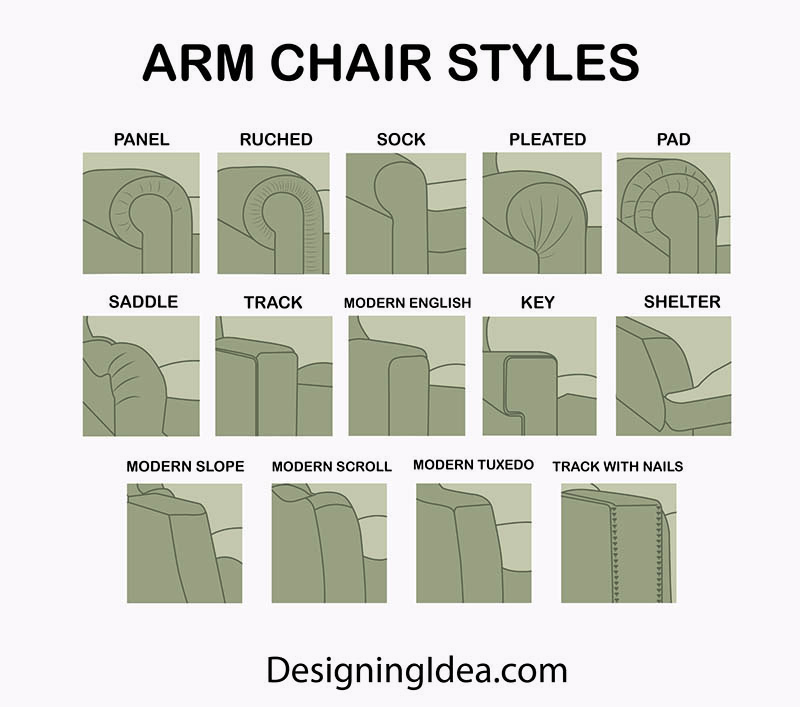
Round arm sofas offer a lot of support to anyone sitting or leaning against it. Compared to other arm styles, the round arm can appear bulky and takes up a lot more space because it is larger.
But overall, it is a very comfortable design and it is perfect to use when you are reading a book or watching tv. Round arm sectionals are perfect if you want classic and graceful furniture pieces.
Track – Track arm sofas have arms that don’t extend out to the sides. Characterized by their sharp straight form, track arm sofas provide firm support and are typically made with a string foam so they can hold their shape. Track arms are also referred to as straight arm styles.
Compared to round arms, track arms are more formal looking and are highly suitable for contemporary style interiors. In addition to their rigid form, this type of sectionals also fit perfectly in small homes.
Pleated – The pleated arm is another type of arm widely used in traditional style sectionals, wherein the inside part of the arm is covered with fabric that is continued to the front.
Armless – Armless sofas are getting more and more popular nowadays due to their sleek modern look. This type can fit perfectly in much tighter spaces compared to those with two bulky arms. However, a disadvantage of armless designs is that they’re less comfortable to use if you sit at the ends of the seat.
If you love the contemporary vibe and seamless look of armless designs, but find it a bit uncomfortable to use you can add pillows to your set up.
Square – Square arms have a straighter form and sharper structure. Because of its crisp lines, geometric form and hard corners, this type of arm is more commonly used in modern, mid century style and Lawson sectional sofas. This style is the perfect choice if you want something classy, elegant and formal.
Pillow Top – Pillow top sofas have small thick arm shaped cushions pads attached to their arms. They are more commonly used on sectionals with attached back cushions.
In some designs,the pillows are removable and are attached with velcro. This is the perfect option if you want soft, plush arms that are ideal for leaning or lying down on.
Recessed – This type has arms that don’t extend to the edge of the seat. The recessed arm is also referred to as “Charles of London” and has become an iconic signature of English style furniture.
Recessed arms and sectionals tend to be more traditional looking and are characterized by an extremely low set and sloping profile. Read more about sofa arm styles here.
Sectional Ideas
Some sectional sofas include special features and added components which make them more convenient to use.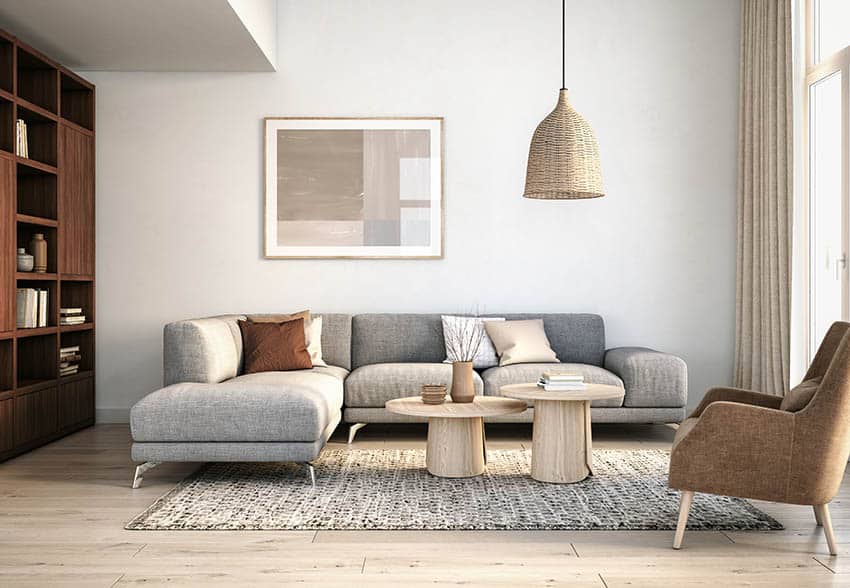
Chaise
Sectional sofas with a chaise allow the user to stretch their feet up comfortably. This is a good alternative if you want to lounge and rest, but do not have a space for an additional ottoman.
Cuddler
A cuddler sectional is designed with an extended cushion at the end of the sofa which allows the user to curl up and cuddle with other people. In terms of shape, the cuddler sectional does not have a straight L or U shaped form, but rather has a slanted piece at the end. They are like a combination of the traditional design and a sectional with a chaise.
Down Filled – Down or feather filled cushions and sofas are considered to be the most luxurious type of cushions. Down is the soft puff of feather found in a bird’s underbelly. They are typically used for high end sofas and are more expensive than foam. Not only are they super plush, soft and comfortable to use, but they also last a very long time.
Power Reclining – Power reclining is a special feature which allow the user to recline with just a push of a button
Hidden Storage – Another notable feature that some designs have is the hidden storage. Sectionals with hidden storage help you maximize your space and does not only give you a place for seating, but a place to stash items like books, blankets, pillows, board games and other stuff.
For most designs, the hidden storage can be found under the chaise or the ottoman. Multipurpose sectionals are your best bet if you have limited space at home.
Slipcover – Slipcovers are removable fitted cloths used as a covering for sofas and couches. If you want to make sure that you can clean your sectional without any hassle, opt for something that has a slipcover. Thuis can be easily removed and washed or dry cleaned in case of any spills.
Convertible – A convertible sectional can be transformed into a full sized bed. Most of these designs include pull-outs which enable it to extend, allowing the user to sleep comfortably on it. Convertible sectionals are perfect if you want to use your living room as a guest room or extra sleeping space.
Ottoman – An ottoman is a piece of furniture with no arms or back that is used as a footstool, stool or table. Some sectionals include an ottoman instead of a long chaise and allow you to stretch out and rest your legs. Unlike an attached chaise, an ottoman gives you more flexibility in terms of layout since you can easily move it around.
Cup Holders – Made specifically for a home theater style room and reclining models include cup holders for movie or sports watching. The cup holders are typically hidden at the armrests located in between the sections. These are extra useful if you want to enjoy drinks while watching or lounging in your living room.
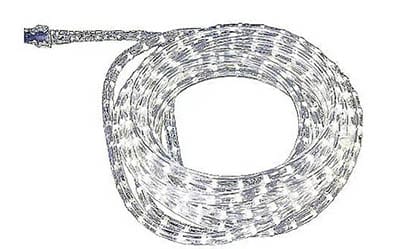
This type of special features are highly suitable if you plan on putting your sectional sofa in your home theater, entertainment, media or game room.
See this LED light strip at Lumens [sponsored link]
High Weight Capacity – In general, the weight capacity of couches and sofas are measured on a “per seat” basis. This typically ranges anywhere from 200 to 300 pounds.
Models that include pull outs and special features like reclining mechanisms lower the total weight capacity to as much as 180 pounds per seat. Whereas, heavy duty furnishings can support more weight and have a limit of up to 350 pounds.
Inflatable – An inflatable sectional comes in a single piece instead of multiple individual pieces. This type can be inflated using a built in pump in just a matter of minutes.
Aside from being easy to set up, you can also deflate it quickly and tuck it away when not in use. The inflatable design also offers mobility as it is completely portable and can be used both indoors and outdoors. You can purchase inflatable sectional sofas online at an affordable price of $140.
Sectional Cost
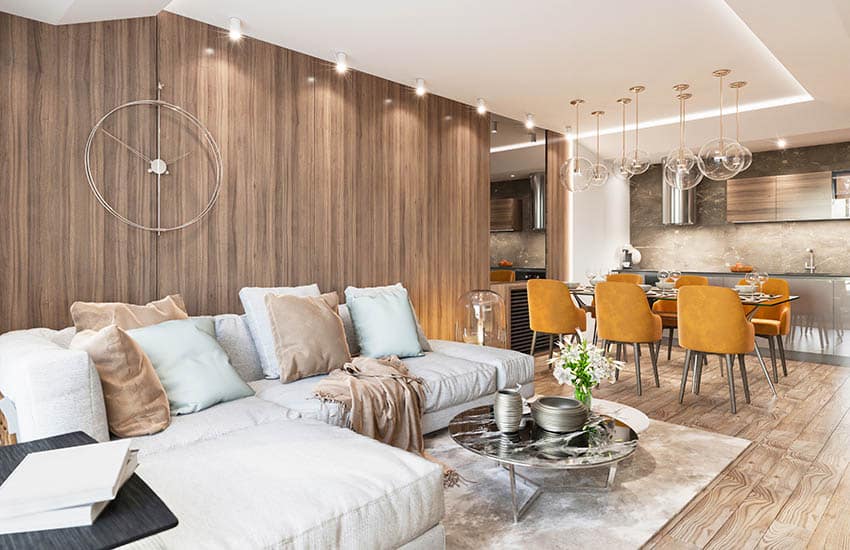
In general, the overall price of a sectional is more expensive than a regular sofa — typically ranging from $1200 to $7000 depending on different factors. The reason being is that it is made up of more individual seating pieces, and typically, the more modular pieces there are in a set, the more expensive the product is.
Aside from the number of pieces, there are a number of other factors which affect the pricing of sectional sofas like the design, materials used, quality, construction and overall comfort. Below are the different classifications of the average prices of sectionals.
Low to Mid Range Sectional Sofa Cost – Prices range between $1200 to $2000. You can find them around this price range without compromising quality. However, the upholstery choices and customization are much more limited compared to their high end counterparts.
The primary materials used for low range sectional are typically solid wood, particleboard and plywood, while the cushions are high density foam supported by sinuous spring suspension.
Most sectionals in this price range already come bundled with throw pillows, and while the upholstery choices are limited, you can find attractive options in both leather and fabrics.
Mid Range Sectional Sofa Cost – Prices range between $2100 to $3500. In this price bracket, the options are more durable and offer premium comfort. The method of construction used to build the pieces also has higher quality.
The cushions have higher foam density — typically 2.2 to 2.5 and do not sag easily. In most cases, they also have different layers to ensure that they provide superior support and comfort. The fabrics and upholstery are also more durable and wear tested.
Aside from better materials, mid range sectionals can be customized depending on your preference, specifications and requirements.
High-End Sectional Cost – prices range from $3500 or higher. High end sectionals are fully customizable — from the sizing of the seat, to the details, materials, special features and mechanisms.
In this price range, you have the choice to include add-ons like recliners or change the details like the nail heads, the leg finish or the seat cushion.
High end sectional puts premium on maximum comfort. Construction of the product is top of the line — making use of high quality materials like kiln dried wood, a superior quality spring system and down filled cushions. There is also a wider selection of upholstery covers.
Sectional Dimensions

Before you buy a new sectional sofa, you need to measure your space to ensure that it fits perfectly. Sectionals can help maximize space but they are a bit tricky to place in a room.
Here are some tips on how to measure a sectional:
How To Measure Sectional
The right way to measure a sectional sofa comes in handy when you want to purchase one and see if it will fit into your home. If you already have one at home and want to relocate it, you can also measure it first. 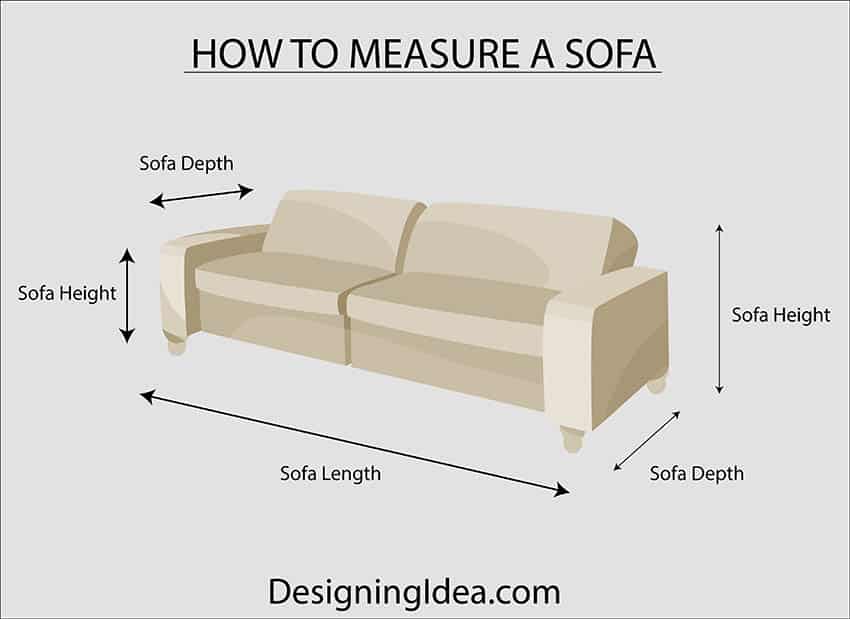
The two primary measurements that you need to focus on when measuring a sectional sofa is the overall length and the overall depth. To get these dimensions, you need a tape measure and you can refer to the following guidelines:
- Overall Length: The total measurement form left arm to right arm and all the pieces in between (loveseat to corner chair or chaise)
The standard overall length of a sectional sofa is usually between 94 inches (8 feet) and 156 inches (13 feet). For more standard sizes we’ve written a sofa dimensions guide on this page.
- Overall Depth: The total measurement of all the components front the front facing edge to the back of the sofa. So if you have an L shaped sectional with a chaise on the right side, you will start measuring from the back of the chaise to the front edge of it.
The standard overall depth of a sectional sofa is usually between 88 inches (around 7 feet) and 168 inches (14 feet).
- Height: The height of a sectional sofa is measured from the base of the sectional to the top of the back. The standard height of sofas ranges between 30 inches to 36 inches.
See our guide on how to measure a sofa for more details.
Measuring a Curved Sectional-Style Sofa
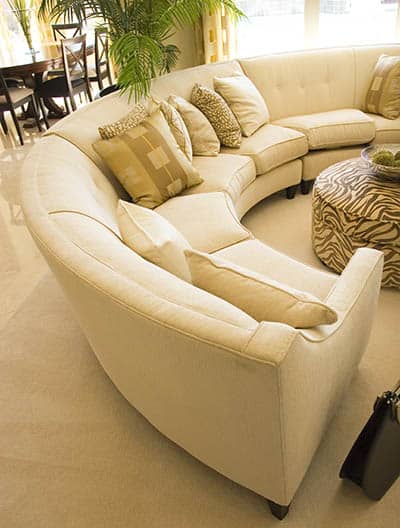
Measurements for curved sectionals or those that have rounded corners can be taken easily by relating the whole set to the smallest imaginary rectangle that it can fit in.
To get the total depth and length of a curved sectional, you can use masking tape or painter’s tape to create or mark a rectangular area around the curved sectional.
Make sure that no part is protruding and the whole set fits within the rectangle.
Use a tape measure to measure the length and depth of the rectangle. The long side of the rectangle will correspond to the overall width of the curved sectional w, while the short side of the rectangle will correspond to the overall depth.
Frequently Asked Questions About Sectionals
Here are some of the answers to the most common questions about buying and styling a sectional sofa:
Most Comfortable Sectional
With thousands of sectional sofa options available in the market, it can be quite hard to rank which one is the best. But based on reliable sources and product reviews, the best overall sectional in terms of comfort, flexibility and price is IKEA’s Infini Furnishings Reversible Sectional.
The Infini Reversible Sectional has a casual yet chic design and comes in two colors, Dark Blue and Charcoal Grey Black — both of which can fit in a wide range of interior color schemes.
This sectional is 118 inches wide, and comes with two sofa and chaise pieces that are securely attached to each other. It can comfortably accommodate four people at a time, while its 84 inch chaise will allow you to comfortably stretch your feet out while watching TV or reading a book.
In terms of design, this sectional has tufted seats and 6 inch thick flat back cushions. This style also comes with two patterned accent pillows, which gives it more visual appeal and a different texture. The sofa’s frame is made from solid wood which makes it very durable and sturdy.
Comfort wise, the Infini is also impressive. Because the cushions are all made with medium firm foam, the seats have just the right amount of softness and hardness in them. The seats are also deep, offer great support and are inviting too. This sofa is also easy to maintain and has removable cushions that can be kept in place using a hook and loop strap.
However, the best thing about it is its flexibility. The sofa and chaise are completely reversible and you can set them up in multiple configurations and orientations. You can easily rearrange them no matter what the layout of your space is. Its style is classic and can work on numerous interior design motifs like transitional, modern and contemporary. Overall, the Infini Furnishings Reversible Sectional is not only fashionable and affordable, but is super versatile, which makes it really worthy to be a part of your home.
How To Place A Rug Under Sectionals
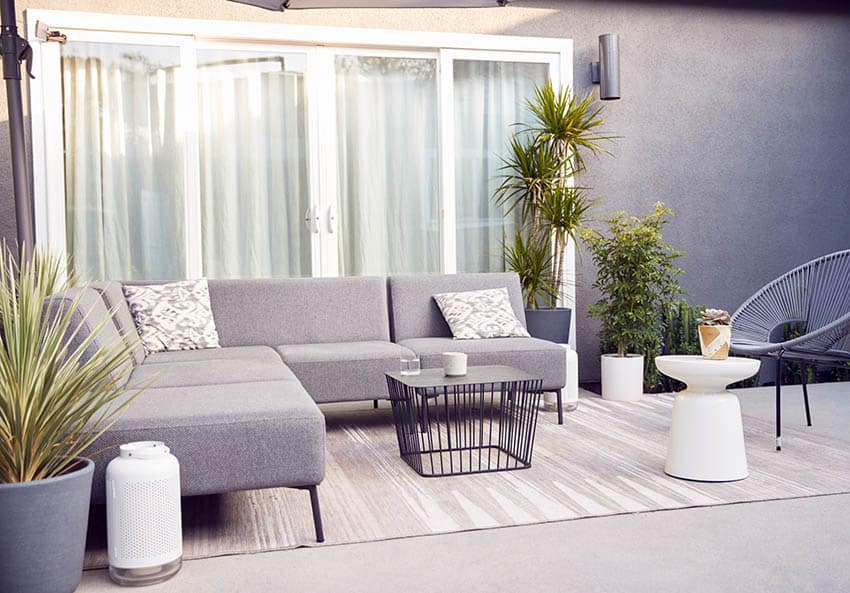
Aside from adding an accent and visual interest to a space, the main purpose of an area rug is to anchor all the décor in the room. Ultimately, there is no hard rule on what size of rug to use, but you can follow some guidelines to effectively frame your sectional sofa.
The rule of thumb when placing a rug under your sectional sofa is that it should fit well under its front legs, then the amount of space around it (or on each side of the rug) must be even. If you plan on putting the area rug under your coffee table, there must be at least three feet of space beyond the table.
How To Choose A Coffee Table With Sectionals
Looking for the right size and shape of a coffee table to match your sectional sofa can be a bit tricky. Sometimes, a coffee table may look too big, too small, off in style or have the wrong shape. The main visual attribute you need to achieve when pairing a coffee table with a sectional sofa is balance. Consider height, width and visual weight and make sure that the coffee table is proportionate to the size and scale of the piece.
Below are some of your recommendations when choosing the right coffee table or ottoman to match with your sectional:
Square or Corner Sectional Sofas – Square or corner sectionals typically have two arms on each end or come in a three piece set.
This style is best paired with a round or square coffee table. Ideally, the dimensions of the table must be at least ⅔ of the total length of the sofa, while the height must be a couple of inches higher or lower than the seat.
Pairing a square sectional with a round coffee table will help soften its shape, while pairing it with a square coffee table will help emphasize the profile and create sharp lines in the space.
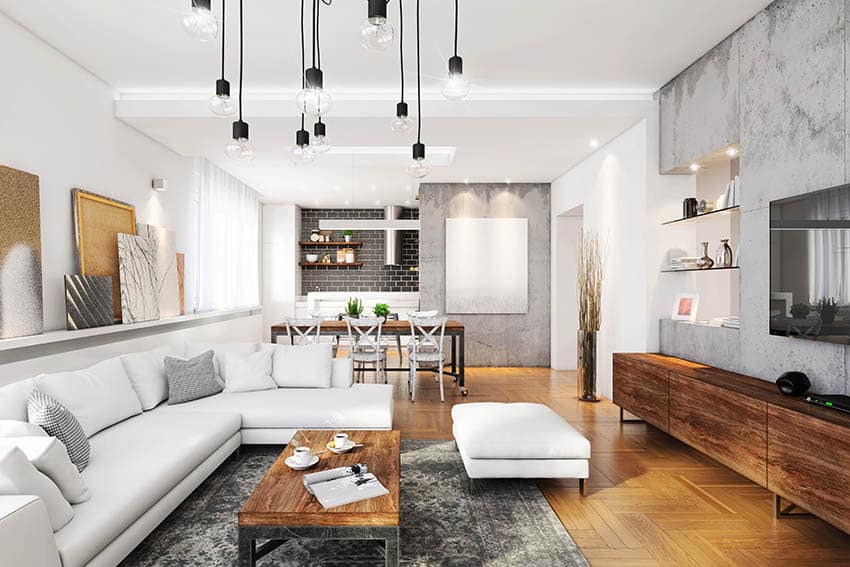
Chaise and L – Shaped Sectional Sofas – Both of these types of sectional have one side longer than the other and are best complemented with an oval or rectangular coffee table. This fills the elongated space and creates proportion. Make sure that your coffee table does not extend beyond the arms of your sectional sofa on both ends.
U- Shaped Sectional Sofas – U shaped sectional sofas are the most flexible and work with a lot of coffee table shapes. Depending on the overall length of your U-shaped sectionals, you can pair it with an oval, square or rectangular coffee table.
In addition to a coffee table, you can also add some side tables to balance the scale and proportion. Round coffee tables are a great option for U shaped sectionals because they are easier to navigate around even when they are fully surrounded by seating. Visit this page if want to read about using an ottoman instead of a coffee table.
Placing Pillows On Sectionals
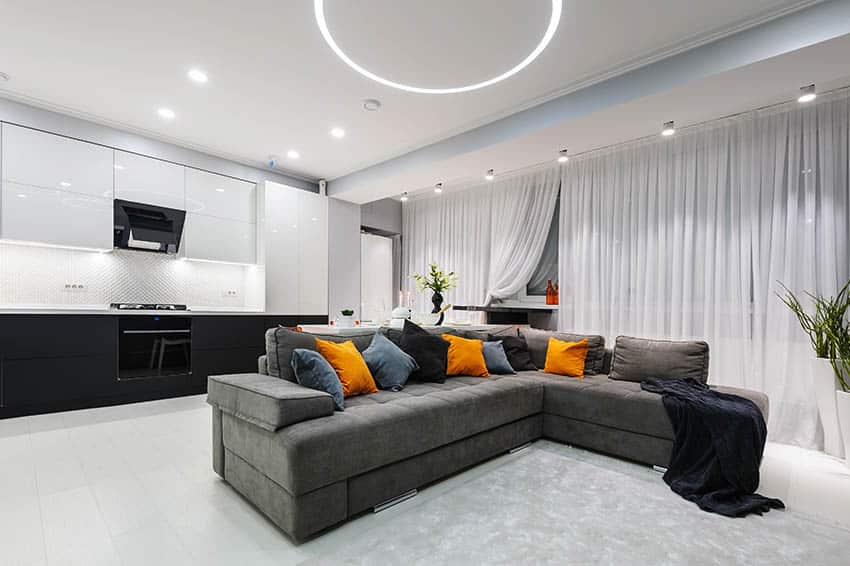
When styling a sectional sofa, it is best to use a combination of different sizes of pillows to create more interest in your décor. You can buy 12 inches, 20 inches, 22 inches and 24 inches pillows and set them up in different ways by layering. Typically, the average number of pillows recommended for most living room sectionals is between seven to nine pieces. Choose different colors and patterns that fit into your room’s color palette and then mix and match them to accentuate the decor.
When placing the pillows on a sectional sofa, start at the back corner and place the largest pillow. You can use a 24 inch pillow for this then layer the front with two pieces of smaller pillows (20 inch pillows). You can do this combination on both ends if you want symmetry, but you can also throw in a small rectangular accent pillow into the mix.
We hope you enjoyed our types of sectional sofas buying guide, do you have a favorite? Let us know in the comments section below.

